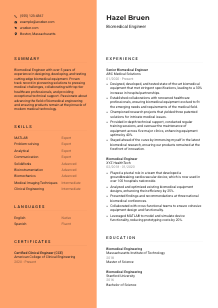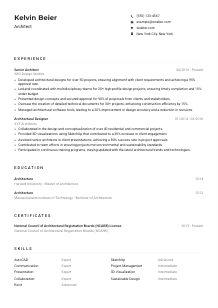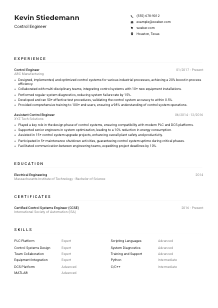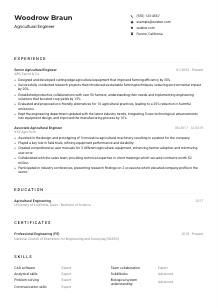Biomedical Engineer Resume Example
Blending medicine and mechanics, but your resume lacks vitality? Breathe life into your qualifications with this Biomedical Engineer resume example, crafted using Wozber free resume builder. Learn how to seamlessly meld your health tech expertise with job specifics, forging a career at the heartbeat of innovation!
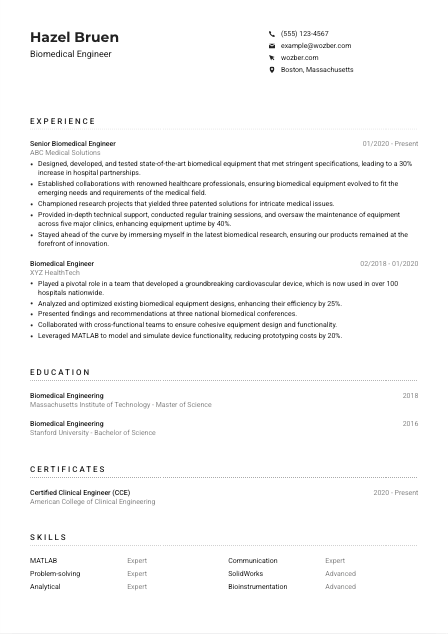
How to write a Biomedical Engineer resume?
Embarking on the quest to land your dream job as a Biomedical Engineer? Your resume is your golden ticket to stand out in the competitive realm of biomedical engineering. With the right blend of precision and innovation, let's sculpt your resume into a masterpiece that showcases your unique skills and experiences. Utilizing the power of Wozber's free resume builder, this guide promises to navigate the intricacies of ATS optimization, ensuring your resume is not just seen but celebrated by hiring managers.
Ready to engineer your success story? Let's dive in!
Personal Details
Crafting a captivating introduction in your resume is akin to setting the stage for an illustrious performance. This is your moment to shine, to ensure every detail in your introduction is perfectly aligned with the expectations of a Biomedical Engineer role. Let's break down this crucial section, ensuring your personal details are not just accurate, but exemplary.
1. Claim Your Name
Let your name be the first thing that catches the eye. Use a clear, readable font and consider making your name somewhat larger than the rest of the text, establishing a strong personal brand right from the get-go.
2. Job Title Juxtaposition
Align your ambition with reality by placing the job title ‘Biomedical Engineer' right below your name, connecting you immediately to the role you're aspiring for. This direct alignment signifies to the hiring manager your focused career trajectory.
3. Essential Contact Elements
Ensure your contact information is accurate and complete. Include a phone number and a professional email address. Stick to a format like firstname.lastname@email.com for a polished look.
4. Geographical Advantage
Given the requirement to be located in or open to relocating to Boston, Massachusetts, highlight your current Boston residency or your willingness to relocate, directly addressing the employer's logistical considerations.
5. Digital Presence
Include your LinkedIn profile or a professional website to offer a comprehensive view of your professional persona. Ensure your LinkedIn profile is an echo of your resume, bolstering your qualifications with a unified voice.
Takeaway
Your introduction is more than mere formalities; it's your resume's handshake. By meticulously aligning it with the role's prerequisites, you're already signaling your candidacy's relevance. Use this space wisely to immediately communicate your suitability and readiness for the Biomedical Engineer position.





Experience
In the heart of your resume lies the experience section, a showcase of your journey, your battles won, and challenges overcome. Here, precision meets passion, demonstrating why you're not just a fit for the role of a Biomedical Engineer but the optimal choice. Let's tailor your experience in a way that resonates with the essence of biomedical engineering.
- Designed, developed, and tested state‑of‑the‑art biomedical equipment that met stringent specifications, leading to a 30% increase in hospital partnerships.
- Established collaborations with renowned healthcare professionals, ensuring biomedical equipment evolved to fit the emerging needs and requirements of the medical field.
- Championed research projects that yielded three patented solutions for intricate medical issues.
- Provided in‑depth technical support, conducted regular training sessions, and oversaw the maintenance of equipment across five major clinics, enhancing equipment uptime by 40%.
- Stayed ahead of the curve by immersing myself in the latest biomedical research, ensuring our products remained at the forefront of innovation.
- Played a pivotal role in a team that developed a groundbreaking cardiovascular device, which is now used in over 100 hospitals nationwide.
- Analyzed and optimized existing biomedical equipment designs, enhancing their efficiency by 25%.
- Presented findings and recommendations at three national biomedical conferences.
- Collaborated with cross‑functional teams to ensure cohesive equipment design and functionality.
- Leveraged MATLAB to model and simulate device functionality, reducing prototyping costs by 20%.
1. Parsing the Role
Start by dissecting the job description. Highlight the requirements such as ‘design, develop, and test biomedical equipment' and compare these to your background. Your goal is to pinpoint overlaps between your accomplishments and what the job necessitates.
2. Chronology and Clarity
Structure your experience section by listing roles chronologically, starting with the most recent. For each position, include your job title, the company's name, and the dates of your employment, presenting a clear progression of your career.
3. Achievement Articulation
Detail your achievements in terms that mirror the responsibilities and requirements of the Biomedical Engineer role. Use action verbs and quantify your accomplishments, showing the depth and impact of your work in the biomedical field.
4. Quantitative Qualifications
Wherever possible, quantify your achievements. Numbers speak volumes, offering tangible proof of your effectiveness and contributions. ‘Led to a 30% increase in hospital partnerships' captures attention by illustrating your direct impact.
5. Relevance Reigns Supreme
Curate your experience to spotlight only the most pertinent roles and responsibilities. Each point should underscore your qualifications for the Biomedical Engineer position, prioritizing relevance over breadth to keep the hiring manager engaged and impressed.
Takeaway
Think of each bullet point as a stepping stone, building a bridge to your future role. Your experience section is not just a list; it's a compelling narrative of your journey, underscoring your readiness to excel as a Biomedical Engineer. Tailor with care, showcase with pride, and prepare to embark on your next chapter in biomedical engineering.
Education
The education section of your resume does more than list degrees; it underlines your foundational knowledge and dedication to the field of biomedical engineering. Let's refine this section to reflect your academic prowess and how it aligns with your career aspirations.
1. Highlighting Key Degrees
Directly reference the educational requirements from the job description, namely a ‘Bachelor's degree in Biomedical Engineering, Bioengineering, or a related field.' If your degrees align, list them prominently to fulfill this essential criterion.
2. Layout Simplification
Maintain clarity and simplicity. For each degree, mention the field of study, degree earned, institution name, and graduation date. This straightforward structure ensures your educational qualifications are easily digestible at a glance.
3. Degree Detailing
For roles that require specific educational backgrounds, such as the Biomedical Engineer position, it's crucial to present your degree details accurately. Highlighting a Master of Science in Biomedical Engineering, for instance, demonstrates not just compliance with the job specifications but a deeper commitment to the field.
4. Relevant Coursework
While not always necessary, for early-career professionals or highly specialized roles, listing pertinent coursework can be beneficial. This might include specialized subjects or projects that directly relate to the biomedical engineering domain, showcasing your focused expertise.
5. Additional Achievements
Don't hesitate to mention academic distinctions, relevant extracurriculars, or significant thesis work, especially if they add value to your candidacy for the Biomedical Engineer role. However, weigh the relevance of these details against the level of the position you're applying for.
Takeaway
Your education is a testament to your commitment to grow and succeed in the biomedical engineering field. By highlighting the relevant aspects of your academic journey, you not only meet the basic requirements but also demonstrate a solid foundation and passion for furthering the field. Let your education section be a mirror of your academic dedication.
Certificates
In the continuously evolving field of biomedical engineering, certificates are not just accolades; they are proof of your dedication to staying ahead of the curve. Let's curate your certificates section to reflect the most relevant and impressive credentials.
1. Identifying Key Qualifications
Refer back to the job description to identify any preferred certifications, such as the Certified Clinical Engineer (CCE) credential. Highlighting such certificates directly responds to the bonus criteria, setting you apart as a committed professional.
2. Selection of Certificates
Focus on listing certifications that resonate with the job's demands. This targeted approach ensures that the hiring manager immediately recognizes your suitability and specialized knowledge for the Biomedical Engineer role.
3. Date Disclosure
Be transparent with the dates of your certifications, especially if they reflect recent achievements or have a validity period. This detail adds to your profile's credibility, indicating your current competency and up-to-date knowledge.
4. Continuous Learning
Emphasize your commitment to professional growth by regularly updating your certifications and seeking new ones that align with your career goals in biomedical engineering. This ongoing pursuit of excellence demonstrates your proactive approach to professional development.
Takeaway
Well-chosen certificates can significantly bolster your candidacy, serving as a testament to your skills, knowledge, and dedication to the biomedical engineering field. Let each certification you list contribute to a compelling narrative of your ongoing professional journey and readiness for the challenges and opportunities of the job.
Skills
The skills section of your resume offers a concise overview of your capabilities, from technical prowess in MATLAB and SolidWorks to soft skills like problem-solving and communication. Let's optimize this section to reflect the skills most relevant to a Biomedical Engineer, aligning directly with the job description.
1. Job Description Analysis
Start by thoroughly reviewing the job description to identify both explicitly stated and implied skills. This comprehensive understanding will guide you in tailoring your skills section to match the expectations for a Biomedical Engineer role.
2. Selective Listing
Focus on listing skills that directly align with the job description. For example, highlighting your expertise in MATLAB and your advanced proficiency in SolidWorks speaks directly to the technical requirements of the role.
3. Organization and Focus
Resist the urge to list every skill you possess. Instead, prioritize those most pertinent to the role of a Biomedical Engineer, ensuring the hiring manager's attention is captured by your most relevant and impressive capabilities.
Takeaway
Your skills section is a snapshot of your professional essence, a clear display of the value you bring to the biomedical engineering field. Approach it as a strategic composition, highlighting your most compelling assets. Let your skills echo the job requirements, positioning you as the ideal candidate for the role.
Languages
In the interconnected arena of biomedical engineering, the ability to communicate in multiple languages can set you apart, offering additional value to prospective employers. Let's align your language skills with the job requirements, enhancing your appeal as a versatile and global-minded professional.
1. Analyzing Job Prerequisites
Examine the job description for any specified language requirements or preferences. For roles like the Biomedical Engineer, where ‘Competence in both spoken and written English is essential,' ensure you list English, clearly indicating your proficiency level.
2. Prioritizing Relevant Languages
List languages according to their relevance and your proficiency. In the case of Biomedical Engineer, positioning English at the top as ‘Native' immediately addresses a key job requirement, while adding any additional languages showcases your broader linguistic capabilities.
3. Additional Language Proficiencies
Don't hesitate to include other languages you're proficient in. This not only demonstrates your cultural adaptability but also opens the door to opportunities in global projects or collaborations within the biomedical field.
4. Proficiency Clarity
Use clear terms to describe your language proficiency, ensuring there's no ambiguity about your ability to communicate effectively. Categories like ‘Native,' ‘Fluent,' ‘Intermediate,' and ‘Basic' offer a quick understanding of your competency.
5. Understanding the Role's Scope
For roles with a regional or global focus, showcasing your language skills can significantly bolster your candidacy. Even if not explicitly mentioned, your linguistic abilities convey your readiness for a diverse and interconnected work environment.
Takeaway
Your ability to communicate in multiple languages is a testament to your adaptability and global perspective, qualities highly valued in the biomedical engineering field. Even if the role seems domestically focused, your linguistic skills hint at potential for international collaboration, making you a compelling choice for any forward-thinking employer.
Summary
Your summary is the narrative distillation of your resume, a compelling preview that entices hiring managers to delve deeper into your qualifications. For a Biomedical Engineer, this section must encapsulate your technical expertise, innovative contributions, and the impact you've made in the field. Let's tailor your summary to resonate with the aspirations of a skilled biomedical engineer.
1. Essence of the Role
Begin by absorbing the heart of the job description. What essential qualities is the employer seeking in a Biomedical Engineer? Identify these core elements to shape your summary around them.
2. Introduction with Impact
Introduce yourself as a professional with a succinct statement about your expertise and role in the biomedical field. This should be a powerful opener that captures the essence of your qualifications and aspirations.
3. Tailored Highlight Reel
Incorporate a few of your most significant achievements and skills that directly align with the job's requirements. This is your chance to briefly showcase the impact you've had in the field and how it positions you as the perfect candidate for the job.
4. Conciseness is Key
Keep your summary tight and impactful. Aim for 3-5 lines that efficiently convey your qualifications, motivations, and the unique value you bring to a Biomedical Engineer role. This teaser sets the tone for the detailed narrative to follow in your resume.
Takeaway
Think of your summary as the overture to your professional symphony. It needs to resonate with the requirements of the Biomedical Engineer role, captivating the hiring manager's interest and compelling them to explore the depths of your expertise. With precision and clarity, let your summary affirm your status as the ideal candidate for the role.
Engineering Your Success
With each section refined and your resume now a tailored testament to your qualifications, you're ready to navigate the application process confidently. Wozber's free resume builder, featuring ATS-friendly resume templates and an ATS resume scanner, has empowered you to craft an ATS-compliant resume suited perfectly for the Biomedical Engineer position. Now, go forth, powered by your ingenuity and Wozber's innovative tools, to embark on your next great adventure in biomedical engineering. Your future awaits!

- Bachelor's degree in Biomedical Engineering, Bioengineering, or a related field.
- Minimum of 3 years of experience in the design, development, and testing of medical devices or systems.
- Strong proficiency in software tools such as MATLAB, SolidWorks, or equivalent.
- Exceptional analytical, problem-solving, and communication skills.
- Certification in Certified Clinical Engineer (CCE) or other relevant certifications is a plus.
- Competence in both spoken and written English is essential.
- Must be located in or willing to relocate to Boston, Massachusetts.
- Design, develop, and test biomedical equipment and devices, ensuring they meet all necessary specifications and regulatory standards.
- Collaborate with healthcare professionals to ascertain the needs and requirements for new biomedical equipment or modifications.
- Conduct research to develop innovative solutions for medical problems and advance the field of biomedical engineering.
- Provide technical support, training, and maintenance for biomedical equipment in clinical settings.
- Stay updated with the latest trends, research, and developments in the field of biomedical engineering to ensure products remain competitive and up-to-date.







